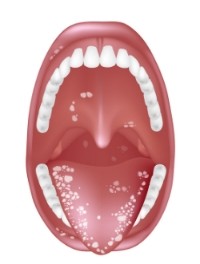Most of us have heard of yeast infections at some point in our lives. The general assumption is that this unpleasant fungal growth only occurs in the genitals. The uncomfortable truth is that you can also get a yeast infection in your mouth.
This oral form of the infection is called Thrush. You can develop Thrush when the fungus Candida albicans is allowed to grow to unacceptable levels. You see, we all have minute amounts of fungus in our mouths at all times. For the most part, our immune system keeps these undesirable and unwanted catalysts at bay. The infection begins when our bodies are overwhelmed and unable to control the fungal growth.

Contents
What Causes Thrush
Thrush usually only occurs in people with compromised immune systems. The elderly and small children will always have a much higher risk of developing oral yeast infections. There are several health related ailments that could leave someone more susceptible to infection. Below are a list of common causes of thrush:
- HIV/AIDS – People with this immune system debilitating virus are very likely to develop Thrush.
- Diabetes – The high blood sugar that diabetics often suffer from can promote the growth of fungus in the mouth.
- Pregnancy – The hormone changes that women go through during their pregnancy make them more prone to infection.
- Lack of oral hygiene – If there is a chance that you could develop Thrush, not caring for your teeth will only guarantee an infection.
- Antibiotics or steroids – These medications often upset the balance of bacteria, both good and bad, in the mouth.
The causes above all have one thing in common, they can hinder your body’s ability to fight off infection.
The Symptoms Of Thrush
 At first, most people who develop oral yeast infections are none the wiser. It is only over time, as the fungus grows, that certain very distinctive symptoms start to rear their ugly heads. Take a look at some of the most common symptoms of Thrush:
At first, most people who develop oral yeast infections are none the wiser. It is only over time, as the fungus grows, that certain very distinctive symptoms start to rear their ugly heads. Take a look at some of the most common symptoms of Thrush:
- Oral lesions – People with severe cases of Thrush will most likely develop lesions on their tongue, the roof of their mouth or their inner cheeks.
- A creamy substance – The fungal build up will create a thick, white, creamy substance that will be most noticeable on the tongue. This residue will have a very unpleasant odor.
- Mouth pain – More often than not, sufferers of Thrush will have mouth pain similar to an internal canker sore.
- Dry, cracked skin – If left untreated, the yeast infection can cause excessive dryness to the point that the skin on the tongue, cheeks and roof of the mouth can start to crack.
These are the most severe symptoms of Thrush. Some more mild symptoms could be dry mouth, bad breath and bad tasting saliva. Your best bet is to seek out medical attention immediately if you suffer from any of these symptoms. The sooner you get help, the better chance of overcoming it quickly.
Treating The Problem
The only sure way to know whether or not you have an oral yeast infection is for your primary care physician to take a throat and mouth culture. This involves swabbing the mouth and throat and attempting to grow any fungus or bacteria in a petri dish. The entire process can be done right in your doctor’s office and will not take very long at all.
 If you are diagnosed with Thrush, it can be treated with the following:
If you are diagnosed with Thrush, it can be treated with the following:
- Clotrimazole lozenges – An anti-fungal lozenge that will release medication in your mouth over time.
- Nystatin – A mouthwash that has anti-fungal properties and will help to kill off the infection.
- Amphotericin – An oral medication used to treat patients with very resistant Thrush strains.
You may also want to take certain steps to help the treatment along on your own. Here are a few things that can be done to lessen the treatment time for Thrush.
- Thoroughly brush your teeth at least twice a day.
- Replace your existing toothbrush.
- Rinse your mouth out with a 3% hydrogen peroxide solution in the morning and before bed.
- Avoid foods that have a high sugar content.
Fortunately, thrush is an easily curable condition that is more of an unpleasant inconvenience than anything else. A simple trip to a health care provider and some extra time brushing your teeth is all you will need to rid yourself of the nasty infection. You can also try out the methods taught in the Yeast Infection No More guide.